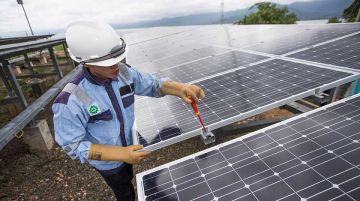
By Cecilia Springer and Hua-Ke (Kate) Chi
Ahead of the 2022 United Nations Climate Change Conference known as COP27, and one year on from Chinese leader Xi Jinping’s announcement that China would step up support for green and low-carbon energy and not build new coal plants overseas, what is the current state of overseas power plants financed by China?
To better understand Chinese-financed power plants around the world, the Boston University Global Development Policy Center launched and recently updated the China’s Global Power (CGP) Database, a public interactive database tracking China’s overseas power projects and measuring them by estimated CO2 emissions, lender or investor, technology, status and capacity.
Our research finds that while China has taken steps to decarbonize its overseas investments and shift towards a green Belt and Road Initiative (BRI), more can be done to decarbonize China’s global power plants, especially in Asia.
China’s policy banks and companies have financed 171.6 GW of generation capacity across 1,423 power generating units representing 648 power plants in 92 countries. Of this capacity, 113.5 GW is operating while an additional 58.1 GW is under construction or planning. Coal represents the greatest share of generating capacity, at 34 percent of the total tracked in the database. The next largest energy sources are hydropower at 29 percent and natural gas at 18 percent. Solar and wind combined total just 12 percent.
Chinese-Financed Overseas Power Plants: Share of Fuel Types by Capacity and Number of Units

Regionally, Asia receives the most loans and investment from China for power generation capacity, with a high concentration of fossil fuel-based power generating capacity, particularly coal-fired projects. The majority of hydropower projects are distributed in the Americas, Asia and Africa, while solar and wind projects span the globe, with the Americas as the largest recipient region at 6.6 GW. In Europe and Oceania, Chinese finance concentrates in natural gas, nuclear and renewable energy projects.
The CGP Database also estimates carbon dioxide (CO2) emissions from the plants it tracks. CO2 emissions from operating plants total 245 million tons (Mt) of CO2 per year, approximately equaling energy-related emissions from the entire country of Spain or Thailand on an annual basis. The median year of commission of fossil fuel-based plants is 2016, which means that over half of these plants are six years or less into their lifetime. Because fossil-fuel based power plants typically operate for decades, cumulative lifetime carbon dioxide (CO2) emissions from these plants will contribute to the global climate crisis. Added up over the plants’ lifetimes, these emissions cumulatively could consume 1.7 percent of the global carbon budget for a 50 percent chance of limiting global warming to 1.5 degrees Celsius.
Following Xi’s no-overseas-coal announcement, China has started to promote green and low-carbon BRI policies. The data reveals several insights to inform reaching this goal. First, Asia is the key region for decarbonization, as it has the largest generating capacity financed by China and over 50 percent is coal-fired power. Full implementation of Xi’s announcement for new coal plants, plus early retirement of existing ones, can contribute to significant emissions avoidance. Second, China’s policy banks have a more carbon-intensive portfolio than investing companies. Of all emissions from currently operating capacity, 62 percent were financed by Chinese policy banks, which have traditionally supported coal power plants and hydropower plants. Given the recent lull in overseas energy finance commitments from China’s policy banks, if and when this finance returns, it will need to be directed towards greener energy. Lastly, Chinese state-owned enterprises tend to have large and carbon-intensive portfolios compared to smaller private companies, many of which invest exclusively in renewable energy in overseas countries.
At the Boston University Global Development Policy Center, we will continue to track how China’s policy banks and investing companies adjust their portfolios to meet Xi’s no-coal announcement and other green BRI guidelines. Explore the data and drop us a line with your thoughts: gdp@bu.edu.
Cecilia Springer is the Assistant Director of the Global China Initiative at the Boston University Global Development Policy Center.
Hua-Ke (Kate) Chi is a Research Assistant with the Global China Initiative at the Boston University Global Development Policy Center and a graduate student in the Department of Economics at Boston University.








